Essay on Academic and Professional Skills Development: Deep Learning
VerifiedAdded on 2021/06/15
|8
|1809
|68
Essay
AI Summary
This essay examines academic and professional skills development, particularly focusing on learning approaches employed by university students. It contrasts deep learning, which emphasizes comprehension and critical thinking, with surface learning, which prioritizes memorization, and strategic learning, which aims for high grades. The essay argues that while teachers encourage deep learning, first-year students often adopt a strategic approach to achieve academic success. It highlights the characteristics of each approach, including how deep learners engage with material, relate knowledge across contexts, and the limitations of surface learning in higher education. The essay also emphasizes the importance of moving beyond rote memorization to foster genuine understanding and the application of knowledge in various contexts. It concludes by suggesting the need for teaching methods that promote deep learning and discourage superficial approaches.
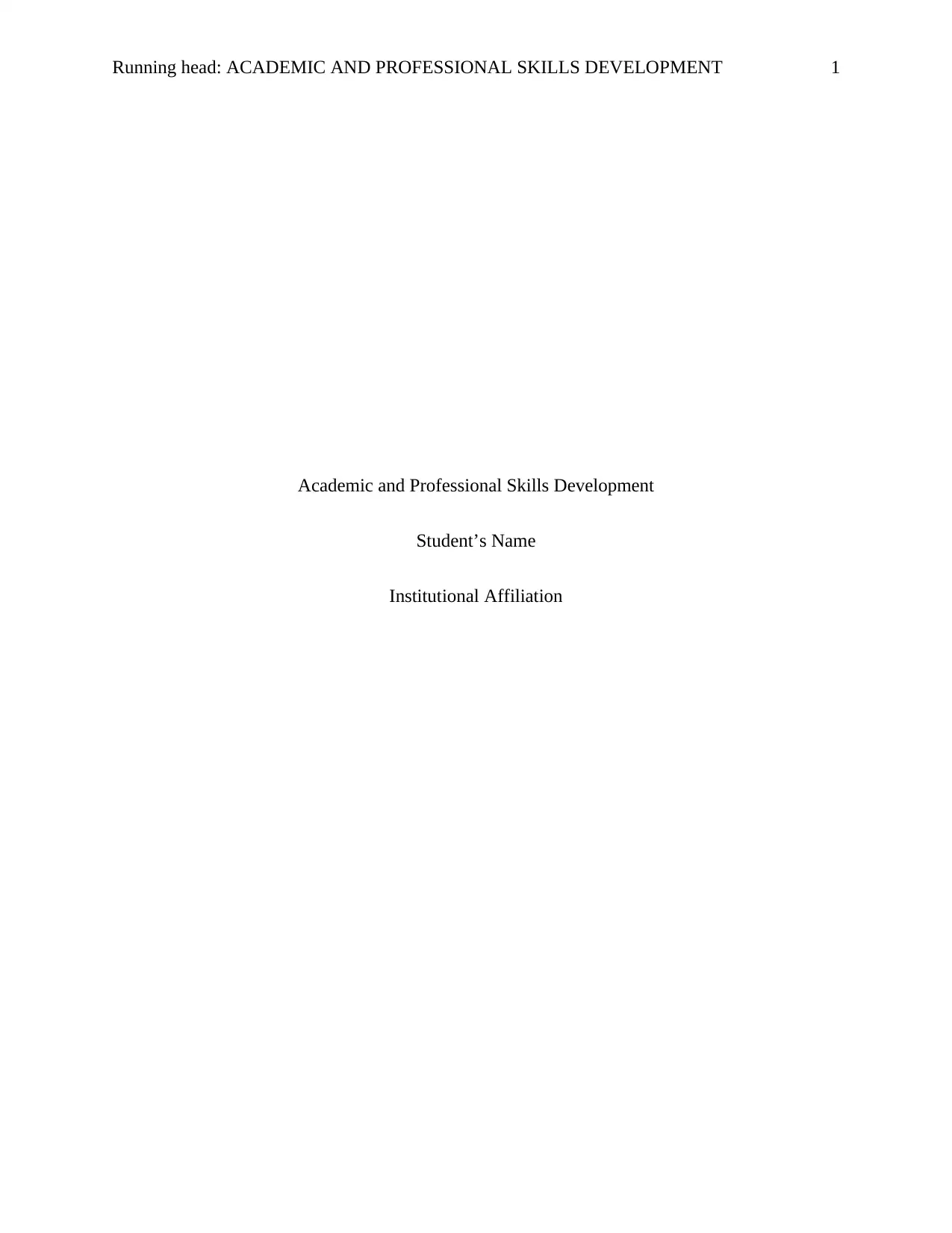
Running head: ACADEMIC AND PROFESSIONAL SKILLS DEVELOPMENT 1
Academic and Professional Skills Development
Student’s Name
Institutional Affiliation
Academic and Professional Skills Development
Student’s Name
Institutional Affiliation
Paraphrase This Document
Need a fresh take? Get an instant paraphrase of this document with our AI Paraphraser
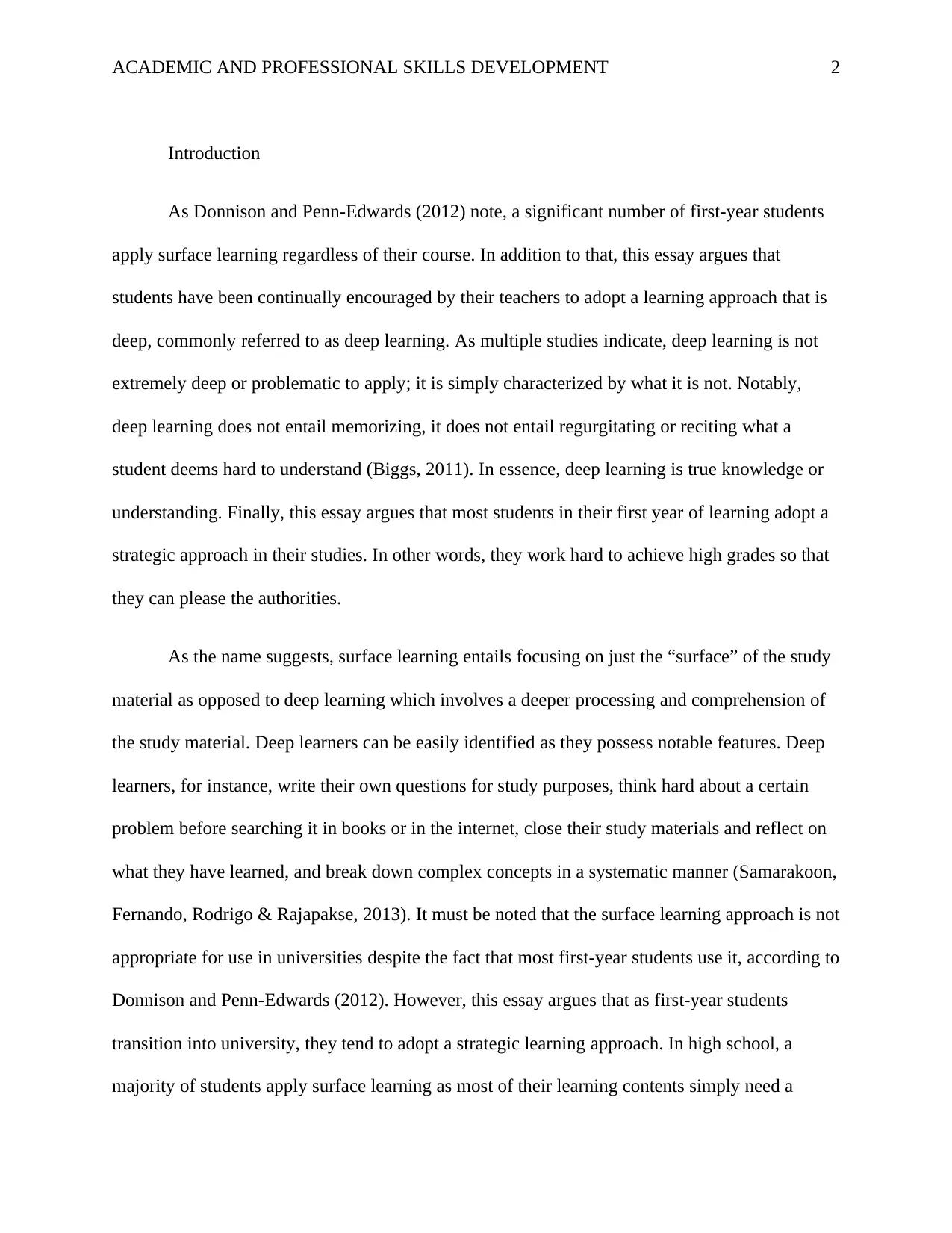
ACADEMIC AND PROFESSIONAL SKILLS DEVELOPMENT 2
Introduction
As Donnison and Penn-Edwards (2012) note, a significant number of first-year students
apply surface learning regardless of their course. In addition to that, this essay argues that
students have been continually encouraged by their teachers to adopt a learning approach that is
deep, commonly referred to as deep learning. As multiple studies indicate, deep learning is not
extremely deep or problematic to apply; it is simply characterized by what it is not. Notably,
deep learning does not entail memorizing, it does not entail regurgitating or reciting what a
student deems hard to understand (Biggs, 2011). In essence, deep learning is true knowledge or
understanding. Finally, this essay argues that most students in their first year of learning adopt a
strategic approach in their studies. In other words, they work hard to achieve high grades so that
they can please the authorities.
As the name suggests, surface learning entails focusing on just the “surface” of the study
material as opposed to deep learning which involves a deeper processing and comprehension of
the study material. Deep learners can be easily identified as they possess notable features. Deep
learners, for instance, write their own questions for study purposes, think hard about a certain
problem before searching it in books or in the internet, close their study materials and reflect on
what they have learned, and break down complex concepts in a systematic manner (Samarakoon,
Fernando, Rodrigo & Rajapakse, 2013). It must be noted that the surface learning approach is not
appropriate for use in universities despite the fact that most first-year students use it, according to
Donnison and Penn-Edwards (2012). However, this essay argues that as first-year students
transition into university, they tend to adopt a strategic learning approach. In high school, a
majority of students apply surface learning as most of their learning contents simply need a
Introduction
As Donnison and Penn-Edwards (2012) note, a significant number of first-year students
apply surface learning regardless of their course. In addition to that, this essay argues that
students have been continually encouraged by their teachers to adopt a learning approach that is
deep, commonly referred to as deep learning. As multiple studies indicate, deep learning is not
extremely deep or problematic to apply; it is simply characterized by what it is not. Notably,
deep learning does not entail memorizing, it does not entail regurgitating or reciting what a
student deems hard to understand (Biggs, 2011). In essence, deep learning is true knowledge or
understanding. Finally, this essay argues that most students in their first year of learning adopt a
strategic approach in their studies. In other words, they work hard to achieve high grades so that
they can please the authorities.
As the name suggests, surface learning entails focusing on just the “surface” of the study
material as opposed to deep learning which involves a deeper processing and comprehension of
the study material. Deep learners can be easily identified as they possess notable features. Deep
learners, for instance, write their own questions for study purposes, think hard about a certain
problem before searching it in books or in the internet, close their study materials and reflect on
what they have learned, and break down complex concepts in a systematic manner (Samarakoon,
Fernando, Rodrigo & Rajapakse, 2013). It must be noted that the surface learning approach is not
appropriate for use in universities despite the fact that most first-year students use it, according to
Donnison and Penn-Edwards (2012). However, this essay argues that as first-year students
transition into university, they tend to adopt a strategic learning approach. In high school, a
majority of students apply surface learning as most of their learning contents simply need a
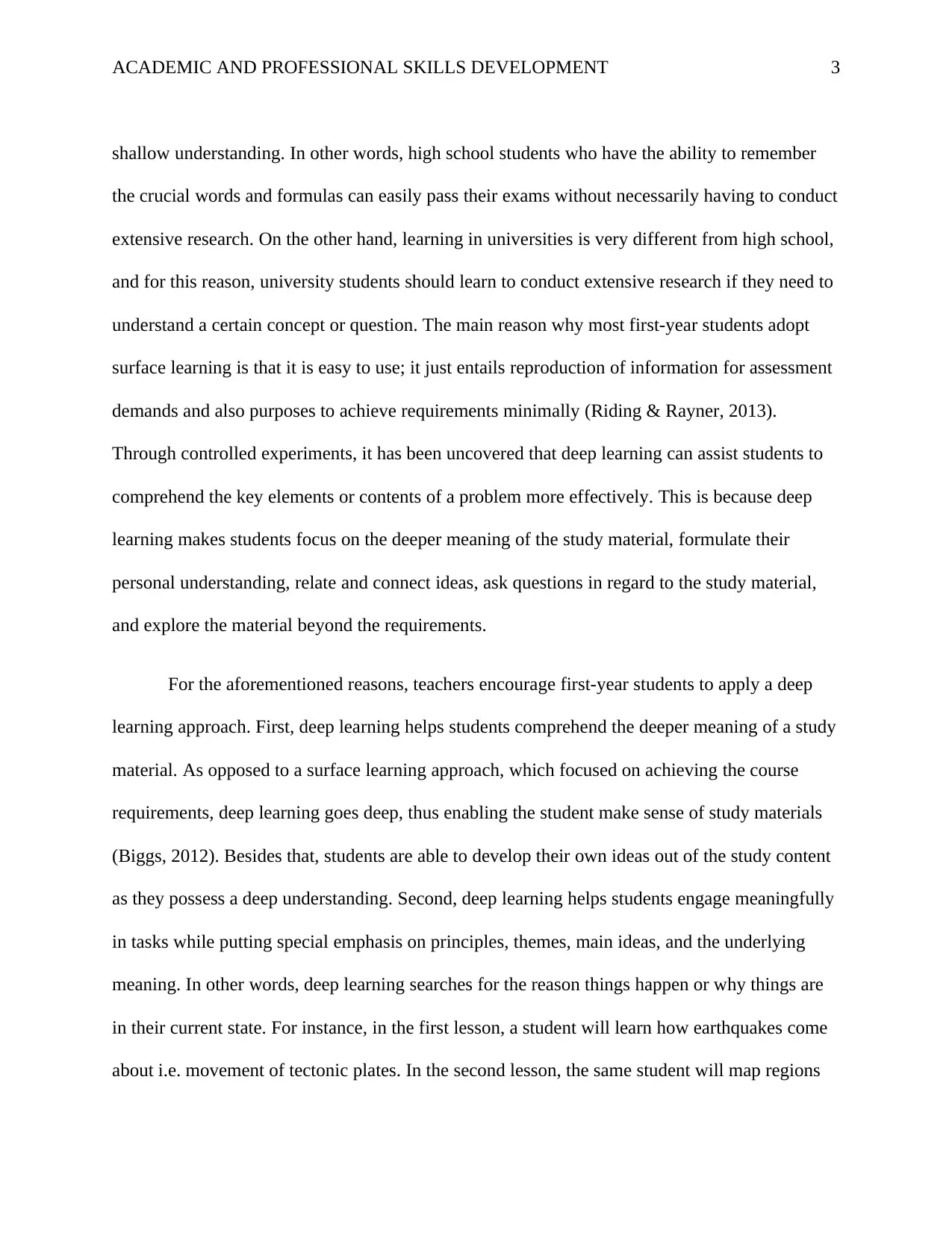
ACADEMIC AND PROFESSIONAL SKILLS DEVELOPMENT 3
shallow understanding. In other words, high school students who have the ability to remember
the crucial words and formulas can easily pass their exams without necessarily having to conduct
extensive research. On the other hand, learning in universities is very different from high school,
and for this reason, university students should learn to conduct extensive research if they need to
understand a certain concept or question. The main reason why most first-year students adopt
surface learning is that it is easy to use; it just entails reproduction of information for assessment
demands and also purposes to achieve requirements minimally (Riding & Rayner, 2013).
Through controlled experiments, it has been uncovered that deep learning can assist students to
comprehend the key elements or contents of a problem more effectively. This is because deep
learning makes students focus on the deeper meaning of the study material, formulate their
personal understanding, relate and connect ideas, ask questions in regard to the study material,
and explore the material beyond the requirements.
For the aforementioned reasons, teachers encourage first-year students to apply a deep
learning approach. First, deep learning helps students comprehend the deeper meaning of a study
material. As opposed to a surface learning approach, which focused on achieving the course
requirements, deep learning goes deep, thus enabling the student make sense of study materials
(Biggs, 2012). Besides that, students are able to develop their own ideas out of the study content
as they possess a deep understanding. Second, deep learning helps students engage meaningfully
in tasks while putting special emphasis on principles, themes, main ideas, and the underlying
meaning. In other words, deep learning searches for the reason things happen or why things are
in their current state. For instance, in the first lesson, a student will learn how earthquakes come
about i.e. movement of tectonic plates. In the second lesson, the same student will map regions
shallow understanding. In other words, high school students who have the ability to remember
the crucial words and formulas can easily pass their exams without necessarily having to conduct
extensive research. On the other hand, learning in universities is very different from high school,
and for this reason, university students should learn to conduct extensive research if they need to
understand a certain concept or question. The main reason why most first-year students adopt
surface learning is that it is easy to use; it just entails reproduction of information for assessment
demands and also purposes to achieve requirements minimally (Riding & Rayner, 2013).
Through controlled experiments, it has been uncovered that deep learning can assist students to
comprehend the key elements or contents of a problem more effectively. This is because deep
learning makes students focus on the deeper meaning of the study material, formulate their
personal understanding, relate and connect ideas, ask questions in regard to the study material,
and explore the material beyond the requirements.
For the aforementioned reasons, teachers encourage first-year students to apply a deep
learning approach. First, deep learning helps students comprehend the deeper meaning of a study
material. As opposed to a surface learning approach, which focused on achieving the course
requirements, deep learning goes deep, thus enabling the student make sense of study materials
(Biggs, 2012). Besides that, students are able to develop their own ideas out of the study content
as they possess a deep understanding. Second, deep learning helps students engage meaningfully
in tasks while putting special emphasis on principles, themes, main ideas, and the underlying
meaning. In other words, deep learning searches for the reason things happen or why things are
in their current state. For instance, in the first lesson, a student will learn how earthquakes come
about i.e. movement of tectonic plates. In the second lesson, the same student will map regions
⊘ This is a preview!⊘
Do you want full access?
Subscribe today to unlock all pages.

Trusted by 1+ million students worldwide
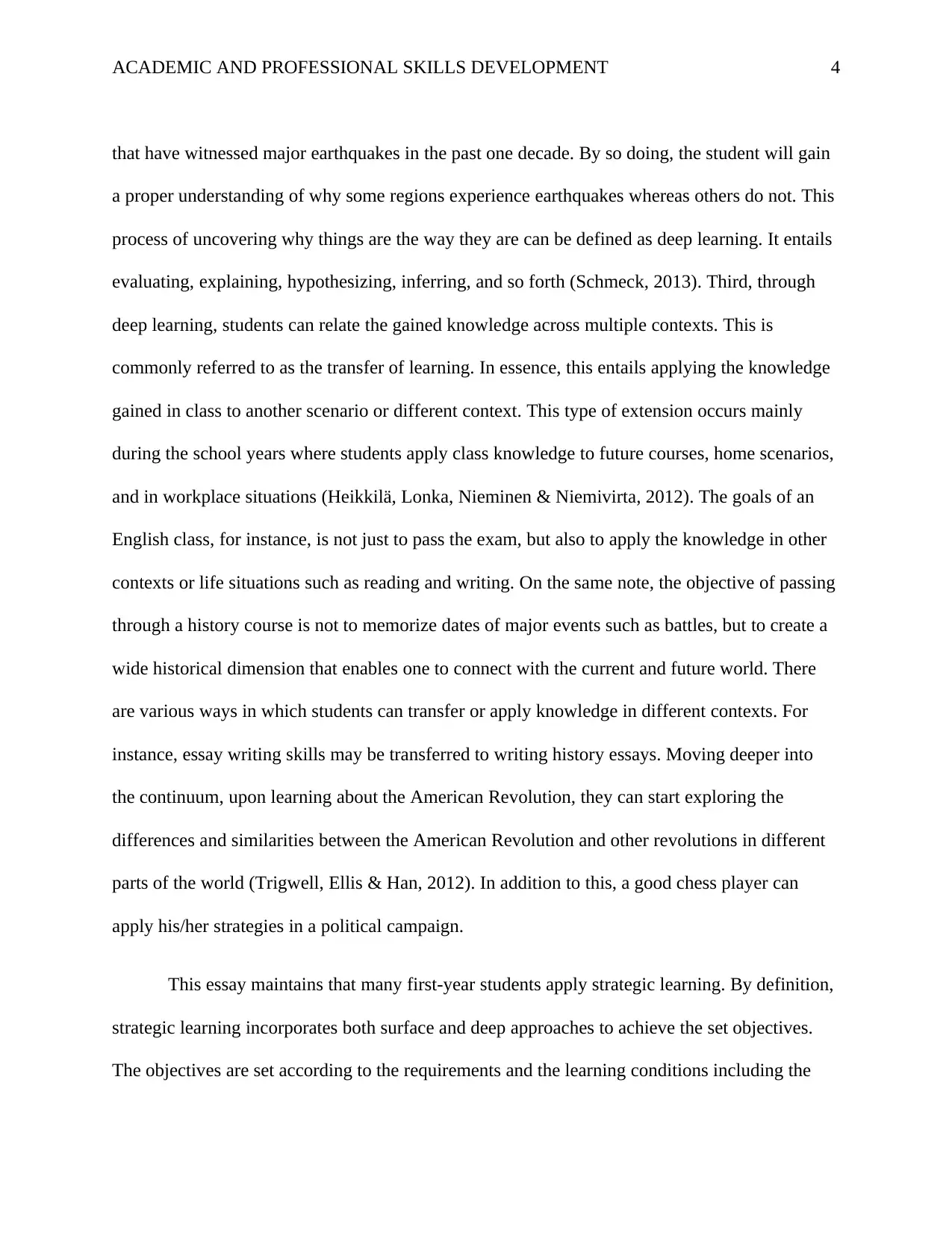
ACADEMIC AND PROFESSIONAL SKILLS DEVELOPMENT 4
that have witnessed major earthquakes in the past one decade. By so doing, the student will gain
a proper understanding of why some regions experience earthquakes whereas others do not. This
process of uncovering why things are the way they are can be defined as deep learning. It entails
evaluating, explaining, hypothesizing, inferring, and so forth (Schmeck, 2013). Third, through
deep learning, students can relate the gained knowledge across multiple contexts. This is
commonly referred to as the transfer of learning. In essence, this entails applying the knowledge
gained in class to another scenario or different context. This type of extension occurs mainly
during the school years where students apply class knowledge to future courses, home scenarios,
and in workplace situations (Heikkilä, Lonka, Nieminen & Niemivirta, 2012). The goals of an
English class, for instance, is not just to pass the exam, but also to apply the knowledge in other
contexts or life situations such as reading and writing. On the same note, the objective of passing
through a history course is not to memorize dates of major events such as battles, but to create a
wide historical dimension that enables one to connect with the current and future world. There
are various ways in which students can transfer or apply knowledge in different contexts. For
instance, essay writing skills may be transferred to writing history essays. Moving deeper into
the continuum, upon learning about the American Revolution, they can start exploring the
differences and similarities between the American Revolution and other revolutions in different
parts of the world (Trigwell, Ellis & Han, 2012). In addition to this, a good chess player can
apply his/her strategies in a political campaign.
This essay maintains that many first-year students apply strategic learning. By definition,
strategic learning incorporates both surface and deep approaches to achieve the set objectives.
The objectives are set according to the requirements and the learning conditions including the
that have witnessed major earthquakes in the past one decade. By so doing, the student will gain
a proper understanding of why some regions experience earthquakes whereas others do not. This
process of uncovering why things are the way they are can be defined as deep learning. It entails
evaluating, explaining, hypothesizing, inferring, and so forth (Schmeck, 2013). Third, through
deep learning, students can relate the gained knowledge across multiple contexts. This is
commonly referred to as the transfer of learning. In essence, this entails applying the knowledge
gained in class to another scenario or different context. This type of extension occurs mainly
during the school years where students apply class knowledge to future courses, home scenarios,
and in workplace situations (Heikkilä, Lonka, Nieminen & Niemivirta, 2012). The goals of an
English class, for instance, is not just to pass the exam, but also to apply the knowledge in other
contexts or life situations such as reading and writing. On the same note, the objective of passing
through a history course is not to memorize dates of major events such as battles, but to create a
wide historical dimension that enables one to connect with the current and future world. There
are various ways in which students can transfer or apply knowledge in different contexts. For
instance, essay writing skills may be transferred to writing history essays. Moving deeper into
the continuum, upon learning about the American Revolution, they can start exploring the
differences and similarities between the American Revolution and other revolutions in different
parts of the world (Trigwell, Ellis & Han, 2012). In addition to this, a good chess player can
apply his/her strategies in a political campaign.
This essay maintains that many first-year students apply strategic learning. By definition,
strategic learning incorporates both surface and deep approaches to achieve the set objectives.
The objectives are set according to the requirements and the learning conditions including the
Paraphrase This Document
Need a fresh take? Get an instant paraphrase of this document with our AI Paraphraser
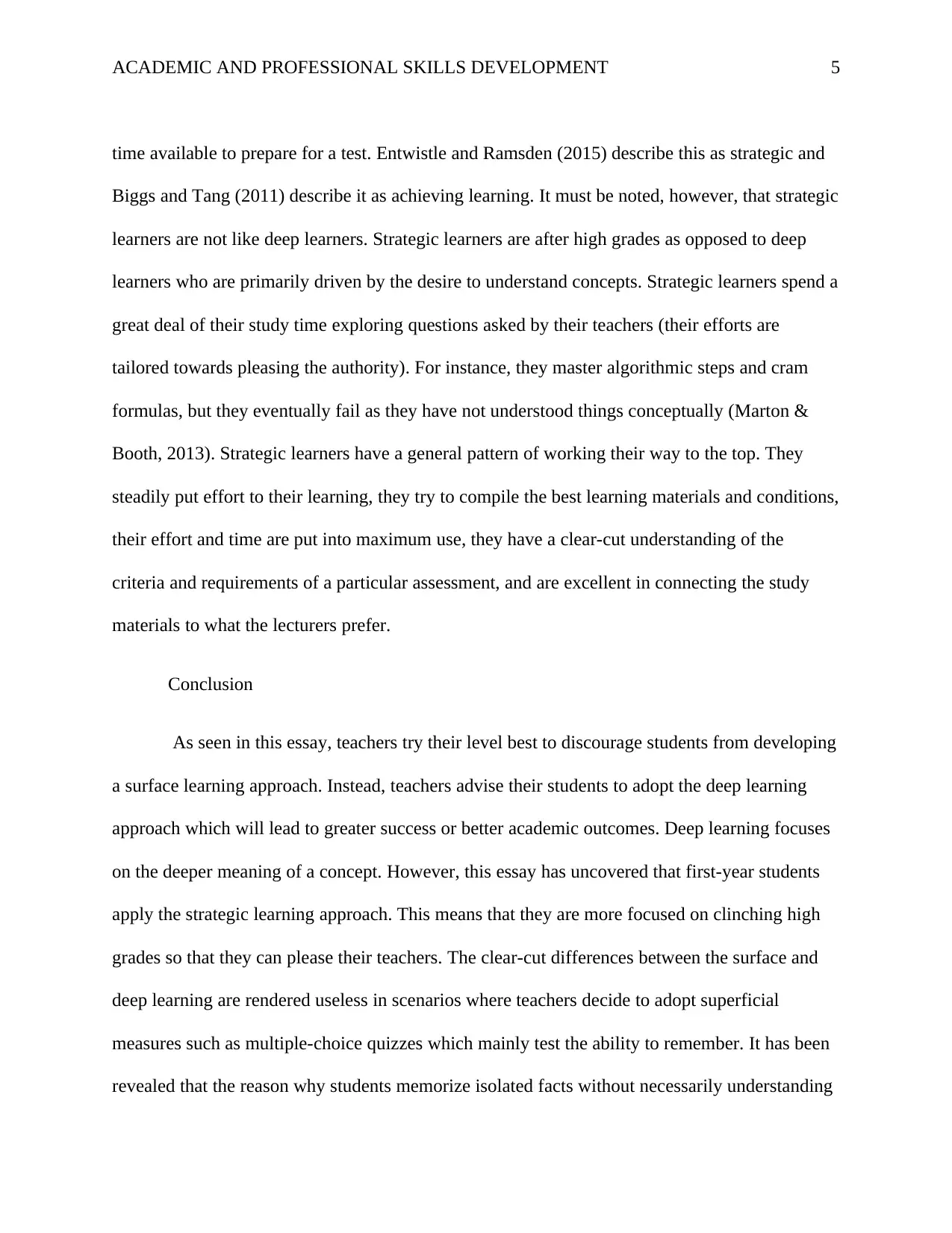
ACADEMIC AND PROFESSIONAL SKILLS DEVELOPMENT 5
time available to prepare for a test. Entwistle and Ramsden (2015) describe this as strategic and
Biggs and Tang (2011) describe it as achieving learning. It must be noted, however, that strategic
learners are not like deep learners. Strategic learners are after high grades as opposed to deep
learners who are primarily driven by the desire to understand concepts. Strategic learners spend a
great deal of their study time exploring questions asked by their teachers (their efforts are
tailored towards pleasing the authority). For instance, they master algorithmic steps and cram
formulas, but they eventually fail as they have not understood things conceptually (Marton &
Booth, 2013). Strategic learners have a general pattern of working their way to the top. They
steadily put effort to their learning, they try to compile the best learning materials and conditions,
their effort and time are put into maximum use, they have a clear-cut understanding of the
criteria and requirements of a particular assessment, and are excellent in connecting the study
materials to what the lecturers prefer.
Conclusion
As seen in this essay, teachers try their level best to discourage students from developing
a surface learning approach. Instead, teachers advise their students to adopt the deep learning
approach which will lead to greater success or better academic outcomes. Deep learning focuses
on the deeper meaning of a concept. However, this essay has uncovered that first-year students
apply the strategic learning approach. This means that they are more focused on clinching high
grades so that they can please their teachers. The clear-cut differences between the surface and
deep learning are rendered useless in scenarios where teachers decide to adopt superficial
measures such as multiple-choice quizzes which mainly test the ability to remember. It has been
revealed that the reason why students memorize isolated facts without necessarily understanding
time available to prepare for a test. Entwistle and Ramsden (2015) describe this as strategic and
Biggs and Tang (2011) describe it as achieving learning. It must be noted, however, that strategic
learners are not like deep learners. Strategic learners are after high grades as opposed to deep
learners who are primarily driven by the desire to understand concepts. Strategic learners spend a
great deal of their study time exploring questions asked by their teachers (their efforts are
tailored towards pleasing the authority). For instance, they master algorithmic steps and cram
formulas, but they eventually fail as they have not understood things conceptually (Marton &
Booth, 2013). Strategic learners have a general pattern of working their way to the top. They
steadily put effort to their learning, they try to compile the best learning materials and conditions,
their effort and time are put into maximum use, they have a clear-cut understanding of the
criteria and requirements of a particular assessment, and are excellent in connecting the study
materials to what the lecturers prefer.
Conclusion
As seen in this essay, teachers try their level best to discourage students from developing
a surface learning approach. Instead, teachers advise their students to adopt the deep learning
approach which will lead to greater success or better academic outcomes. Deep learning focuses
on the deeper meaning of a concept. However, this essay has uncovered that first-year students
apply the strategic learning approach. This means that they are more focused on clinching high
grades so that they can please their teachers. The clear-cut differences between the surface and
deep learning are rendered useless in scenarios where teachers decide to adopt superficial
measures such as multiple-choice quizzes which mainly test the ability to remember. It has been
revealed that the reason why students memorize isolated facts without necessarily understanding
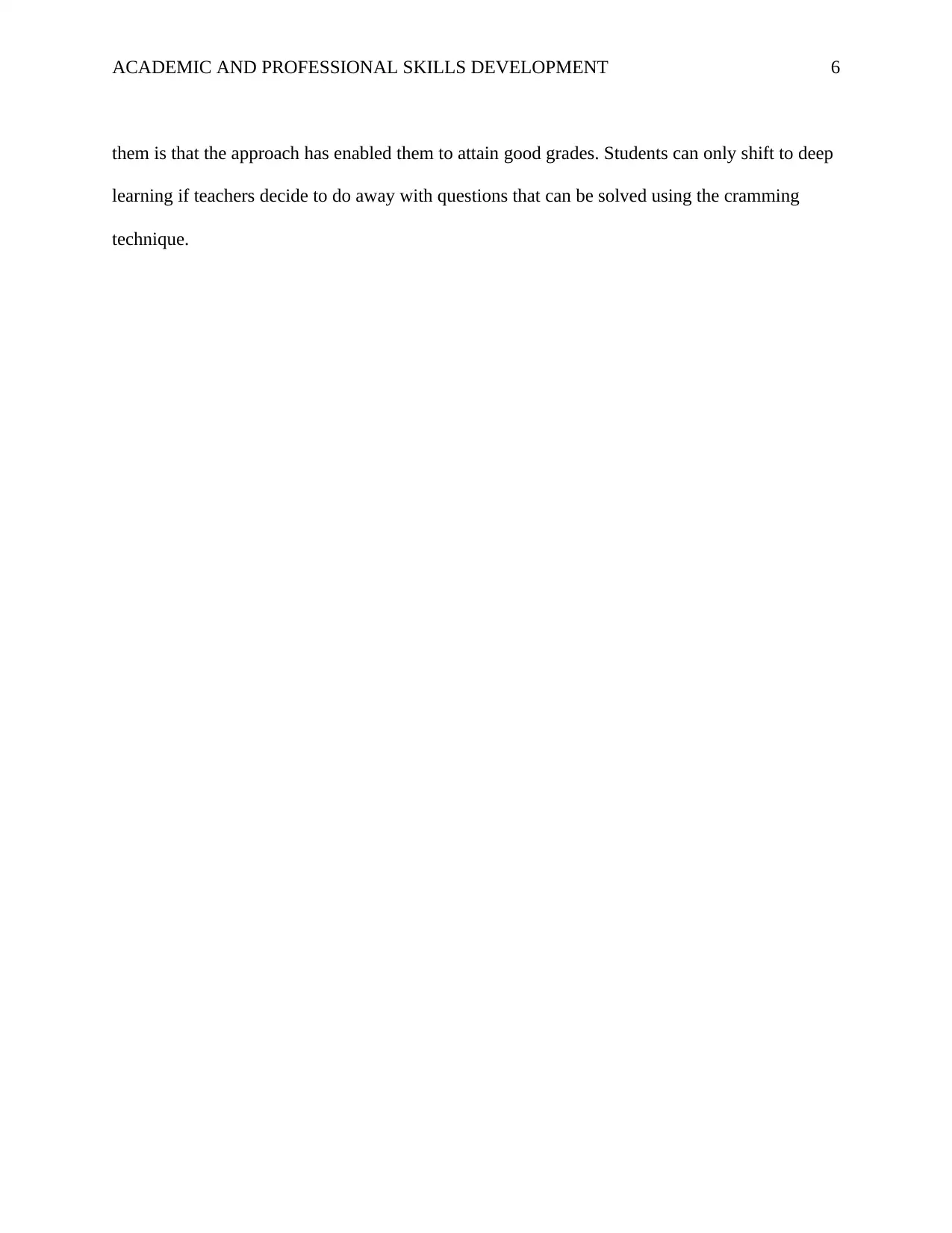
ACADEMIC AND PROFESSIONAL SKILLS DEVELOPMENT 6
them is that the approach has enabled them to attain good grades. Students can only shift to deep
learning if teachers decide to do away with questions that can be solved using the cramming
technique.
them is that the approach has enabled them to attain good grades. Students can only shift to deep
learning if teachers decide to do away with questions that can be solved using the cramming
technique.
⊘ This is a preview!⊘
Do you want full access?
Subscribe today to unlock all pages.

Trusted by 1+ million students worldwide
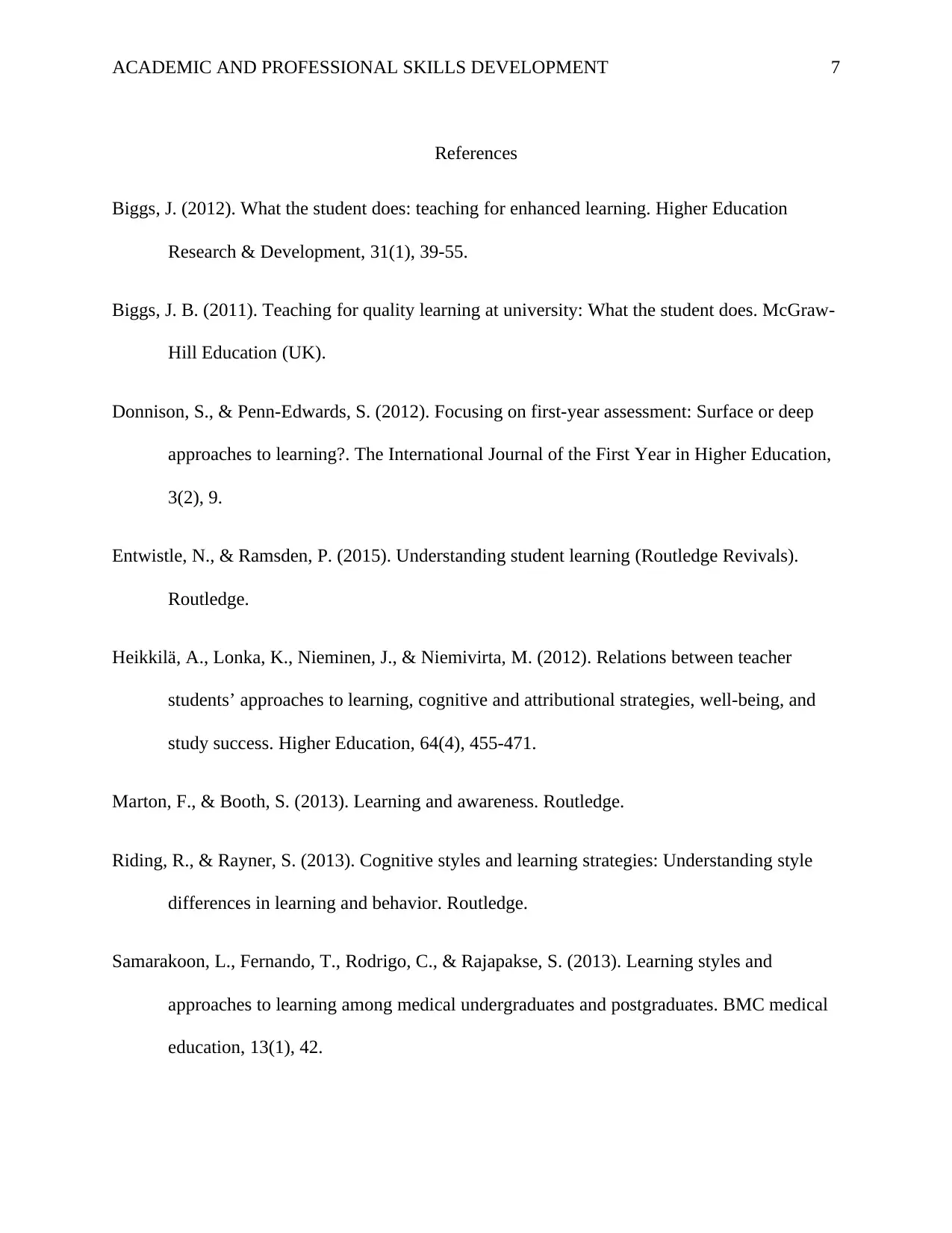
ACADEMIC AND PROFESSIONAL SKILLS DEVELOPMENT 7
References
Biggs, J. (2012). What the student does: teaching for enhanced learning. Higher Education
Research & Development, 31(1), 39-55.
Biggs, J. B. (2011). Teaching for quality learning at university: What the student does. McGraw-
Hill Education (UK).
Donnison, S., & Penn-Edwards, S. (2012). Focusing on first-year assessment: Surface or deep
approaches to learning?. The International Journal of the First Year in Higher Education,
3(2), 9.
Entwistle, N., & Ramsden, P. (2015). Understanding student learning (Routledge Revivals).
Routledge.
Heikkilä, A., Lonka, K., Nieminen, J., & Niemivirta, M. (2012). Relations between teacher
students’ approaches to learning, cognitive and attributional strategies, well-being, and
study success. Higher Education, 64(4), 455-471.
Marton, F., & Booth, S. (2013). Learning and awareness. Routledge.
Riding, R., & Rayner, S. (2013). Cognitive styles and learning strategies: Understanding style
differences in learning and behavior. Routledge.
Samarakoon, L., Fernando, T., Rodrigo, C., & Rajapakse, S. (2013). Learning styles and
approaches to learning among medical undergraduates and postgraduates. BMC medical
education, 13(1), 42.
References
Biggs, J. (2012). What the student does: teaching for enhanced learning. Higher Education
Research & Development, 31(1), 39-55.
Biggs, J. B. (2011). Teaching for quality learning at university: What the student does. McGraw-
Hill Education (UK).
Donnison, S., & Penn-Edwards, S. (2012). Focusing on first-year assessment: Surface or deep
approaches to learning?. The International Journal of the First Year in Higher Education,
3(2), 9.
Entwistle, N., & Ramsden, P. (2015). Understanding student learning (Routledge Revivals).
Routledge.
Heikkilä, A., Lonka, K., Nieminen, J., & Niemivirta, M. (2012). Relations between teacher
students’ approaches to learning, cognitive and attributional strategies, well-being, and
study success. Higher Education, 64(4), 455-471.
Marton, F., & Booth, S. (2013). Learning and awareness. Routledge.
Riding, R., & Rayner, S. (2013). Cognitive styles and learning strategies: Understanding style
differences in learning and behavior. Routledge.
Samarakoon, L., Fernando, T., Rodrigo, C., & Rajapakse, S. (2013). Learning styles and
approaches to learning among medical undergraduates and postgraduates. BMC medical
education, 13(1), 42.
Paraphrase This Document
Need a fresh take? Get an instant paraphrase of this document with our AI Paraphraser
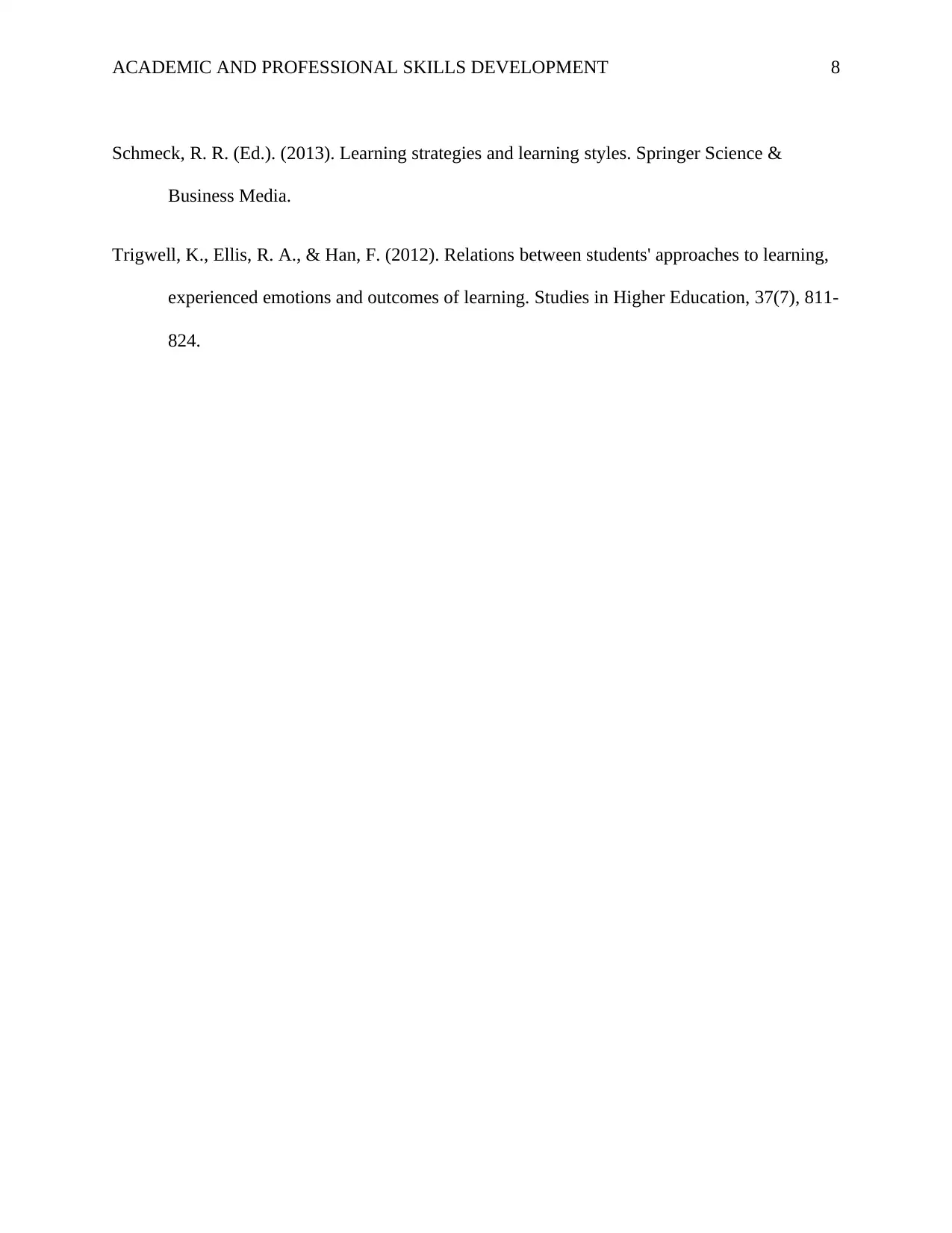
ACADEMIC AND PROFESSIONAL SKILLS DEVELOPMENT 8
Schmeck, R. R. (Ed.). (2013). Learning strategies and learning styles. Springer Science &
Business Media.
Trigwell, K., Ellis, R. A., & Han, F. (2012). Relations between students' approaches to learning,
experienced emotions and outcomes of learning. Studies in Higher Education, 37(7), 811-
824.
Schmeck, R. R. (Ed.). (2013). Learning strategies and learning styles. Springer Science &
Business Media.
Trigwell, K., Ellis, R. A., & Han, F. (2012). Relations between students' approaches to learning,
experienced emotions and outcomes of learning. Studies in Higher Education, 37(7), 811-
824.
1 out of 8
Related Documents
Your All-in-One AI-Powered Toolkit for Academic Success.
+13062052269
info@desklib.com
Available 24*7 on WhatsApp / Email
![[object Object]](/_next/static/media/star-bottom.7253800d.svg)
Unlock your academic potential
Copyright © 2020–2025 A2Z Services. All Rights Reserved. Developed and managed by ZUCOL.




